Page 310 of 446
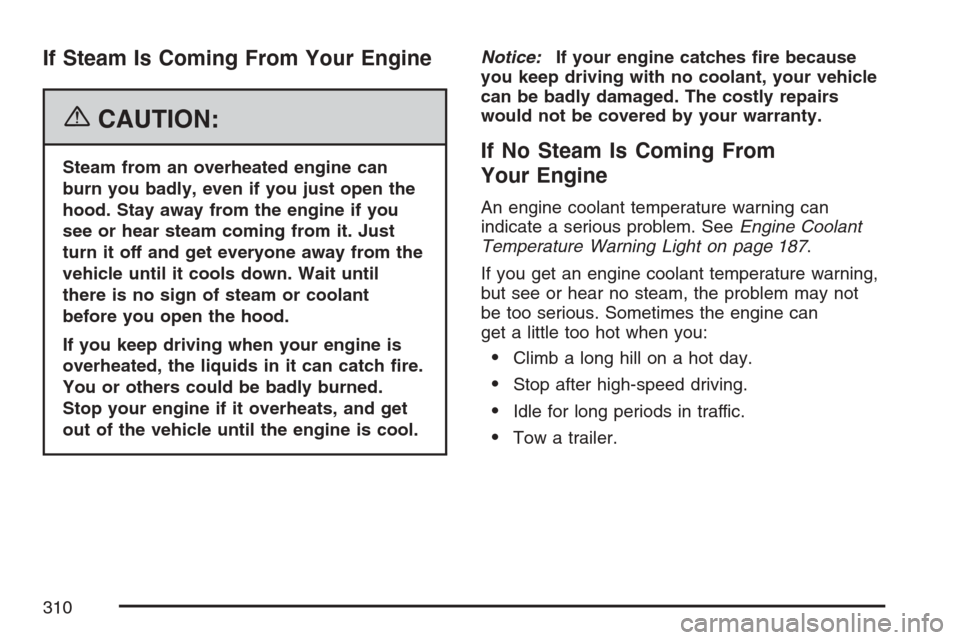
If Steam Is Coming From Your Engine
{CAUTION:
Steam from an overheated engine can
burn you badly, even if you just open the
hood. Stay away from the engine if you
see or hear steam coming from it. Just
turn it off and get everyone away from the
vehicle until it cools down. Wait until
there is no sign of steam or coolant
before you open the hood.
If you keep driving when your engine is
overheated, the liquids in it can catch �re.
You or others could be badly burned.
Stop your engine if it overheats, and get
out of the vehicle until the engine is cool.Notice:If your engine catches �re because
you keep driving with no coolant, your vehicle
can be badly damaged. The costly repairs
would not be covered by your warranty.If No Steam Is Coming From
Your Engine
An engine coolant temperature warning can
indicate a serious problem. SeeEngine Coolant
Temperature Warning Light on page 187.
If you get an engine coolant temperature warning,
but see or hear no steam, the problem may not
be too serious. Sometimes the engine can
get a little too hot when you:
Climb a long hill on a hot day.
Stop after high-speed driving.
Idle for long periods in traffic.
Tow a trailer.
310
Page 311 of 446
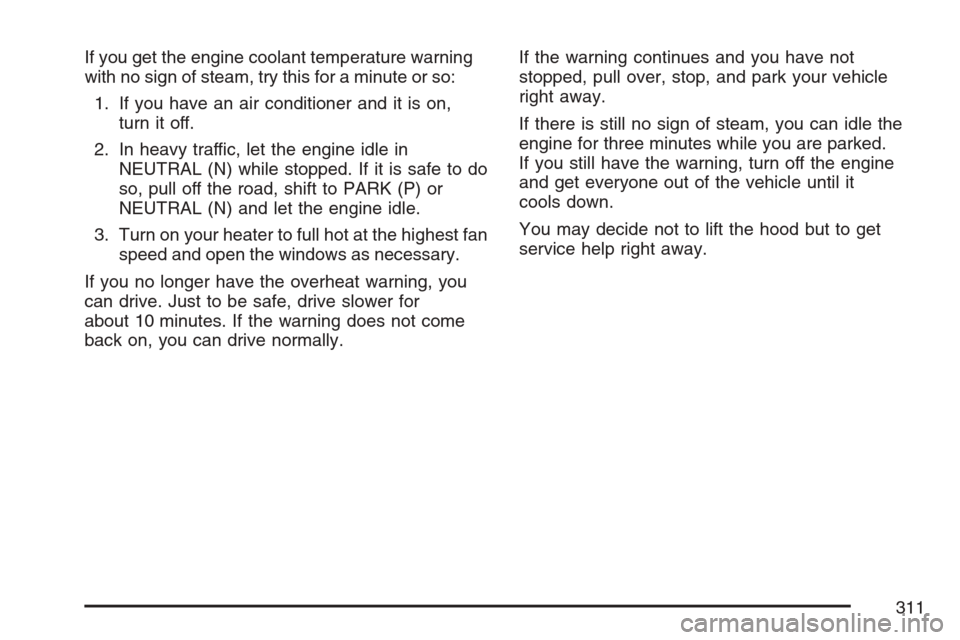
If you get the engine coolant temperature warning
with no sign of steam, try this for a minute or so:
1. If you have an air conditioner and it is on,
turn it off.
2. In heavy traffic, let the engine idle in
NEUTRAL (N) while stopped. If it is safe to do
so, pull off the road, shift to PARK (P) or
NEUTRAL (N) and let the engine idle.
3. Turn on your heater to full hot at the highest fan
speed and open the windows as necessary.
If you no longer have the overheat warning, you
can drive. Just to be safe, drive slower for
about 10 minutes. If the warning does not come
back on, you can drive normally.If the warning continues and you have not
stopped, pull over, stop, and park your vehicle
right away.
If there is still no sign of steam, you can idle the
engine for three minutes while you are parked.
If you still have the warning, turn off the engine
and get everyone out of the vehicle until it
cools down.
You may decide not to lift the hood but to get
service help right away.
311
Page 312 of 446
Cooling System
When you decide it is safe to lift the hood, here is
what you will see:
A. Pressure Cap
B. Coolant Recovery Tank
C. Electric Engine Cooling Fan{CAUTION:
An electric engine cooling fan under the
hood can start up even when the engine
is not running and can injure you. Keep
hands, clothing, and tools away from any
underhood electric fan.
If the coolant inside the coolant recovery tank is
boiling, do not do anything else until it cools down.
The vehicle should be parked on a level surface.
When the engine is cold, the coolant level
should be at or above the COLD FILL line. If it is
not, you may have a leak at the pressure cap
or in the radiator hoses, heater hoses, radiator,
water pump, or somewhere in the cooling system.
312
Page 313 of 446
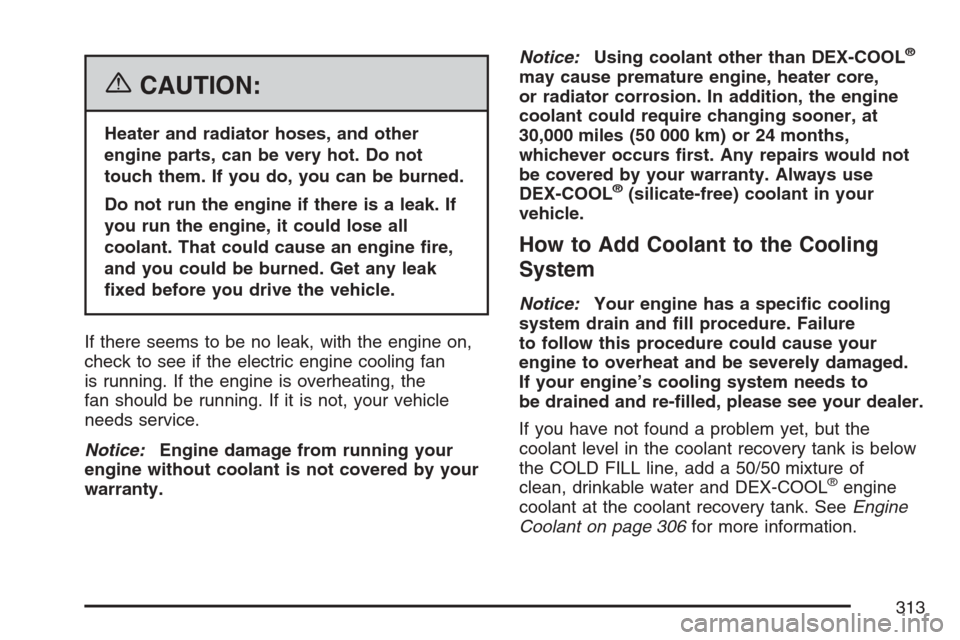
{CAUTION:
Heater and radiator hoses, and other
engine parts, can be very hot. Do not
touch them. If you do, you can be burned.
Do not run the engine if there is a leak. If
you run the engine, it could lose all
coolant. That could cause an engine �re,
and you could be burned. Get any leak
�xed before you drive the vehicle.
If there seems to be no leak, with the engine on,
check to see if the electric engine cooling fan
is running. If the engine is overheating, the
fan should be running. If it is not, your vehicle
needs service.
Notice:Engine damage from running your
engine without coolant is not covered by your
warranty.Notice:Using coolant other than DEX-COOL
®
may cause premature engine, heater core,
or radiator corrosion. In addition, the engine
coolant could require changing sooner, at
30,000 miles (50 000 km) or 24 months,
whichever occurs �rst. Any repairs would not
be covered by your warranty. Always use
DEX-COOL
®(silicate-free) coolant in your
vehicle.
How to Add Coolant to the Cooling
System
Notice:Your engine has a speci�c cooling
system drain and �ll procedure. Failure
to follow this procedure could cause your
engine to overheat and be severely damaged.
If your engine’s cooling system needs to
be drained and re-�lled, please see your dealer.
If you have not found a problem yet, but the
coolant level in the coolant recovery tank is below
the COLD FILL line, add a 50/50 mixture of
clean, drinkable water and DEX-COOL
®engine
coolant at the coolant recovery tank. SeeEngine
Coolant on page 306for more information.
313
Page 314 of 446
If no coolant is visible in the coolant recovery tank,
add coolant at the pressure cap as follows:
{CAUTION:
Steam and scalding liquids from a hot
cooling system can blow out and burn
you badly. They are under pressure, and if
you turn the pressure cap — even a
little — they can come out at high speed.
Never turn the cap when the cooling
system, including the pressure cap, is hot.
Wait for the cooling system and pressure
cap to cool if you ever have to turn the
pressure cap.
{CAUTION:
Adding only plain water to your cooling
system can be dangerous. Plain water, or
some other liquid such as alcohol, can
boil before the proper coolant mixture will.
Your vehicle’s coolant warning system is
set for the proper coolant mixture. With
plain water or the wrong mixture, your
engine could get too hot but you would
not get the overheat warning. Your engine
could catch �re and you or others could
be burned. Use a 50/50 mixture of clean,
drinkable water and DEX-COOL
®coolant.
314
Page 315 of 446
Notice:In cold weather, water can freeze and
crack the engine, radiator, heater core and
other parts. Use the recommended coolant and
the proper coolant mixture.
{CAUTION:
You can be burned if you spill coolant on
hot engine parts. Coolant contains
ethylene glycol and it will burn if the
engine parts are hot enough. Do not spill
coolant on a hot engine.1. You can remove the
pressure cap when
the cooling system,
including the
pressure cap and
upper radiator hose,
is no longer hot.
Turn the pressure
cap slowly
counterclockwise.
If you hear a hiss, wait for that to stop. A hiss
means there is still some pressure left to
be vented.
2. Then keep turning the pressure cap and
remove it.
3. Add the proper DEX-COOL
®coolant mixture
to the coolant �ll port, up to the base of the
port. SeeEngine Coolant on page 306
for more information about the proper coolant
mixture.
4. Rinse or wipe any spilled coolant from the
engine and the compartment.
315
Page 316 of 446
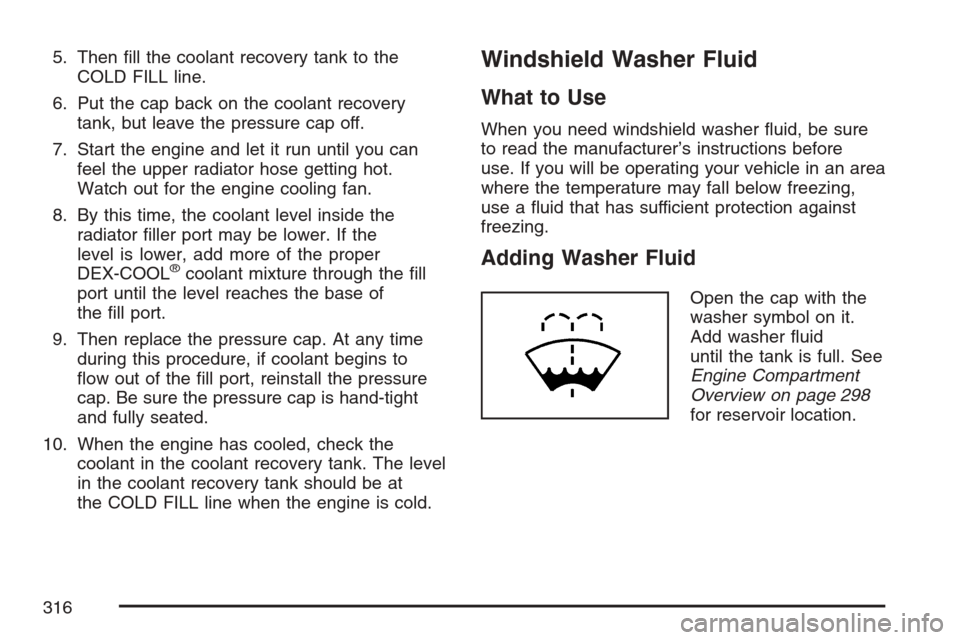
5. Then �ll the coolant recovery tank to the
COLD FILL line.
6. Put the cap back on the coolant recovery
tank, but leave the pressure cap off.
7. Start the engine and let it run until you can
feel the upper radiator hose getting hot.
Watch out for the engine cooling fan.
8. By this time, the coolant level inside the
radiator �ller port may be lower. If the
level is lower, add more of the proper
DEX-COOL
®coolant mixture through the �ll
port until the level reaches the base of
the �ll port.
9. Then replace the pressure cap. At any time
during this procedure, if coolant begins to
�ow out of the �ll port, reinstall the pressure
cap. Be sure the pressure cap is hand-tight
and fully seated.
10. When the engine has cooled, check the
coolant in the coolant recovery tank. The level
in the coolant recovery tank should be at
the COLD FILL line when the engine is cold.
Windshield Washer Fluid
What to Use
When you need windshield washer �uid, be sure
to read the manufacturer’s instructions before
use. If you will be operating your vehicle in an area
where the temperature may fall below freezing,
use a �uid that has sufficient protection against
freezing.
Adding Washer Fluid
Open the cap with the
washer symbol on it.
Add washer �uid
until the tank is full. See
Engine Compartment
Overview on page 298
for reservoir location.
316
Page 317 of 446
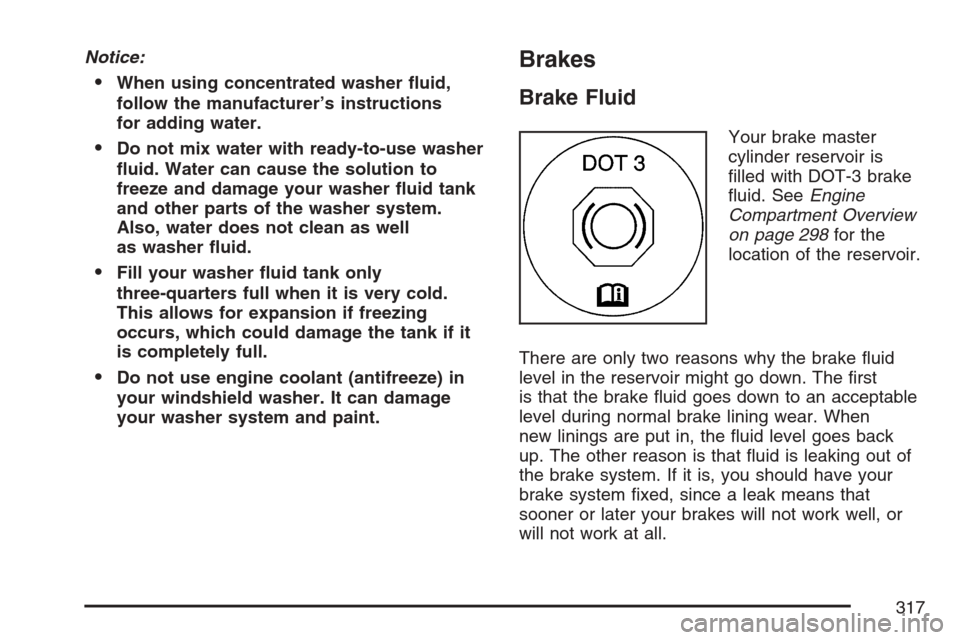
Notice:
When using concentrated washer �uid,
follow the manufacturer’s instructions
for adding water.
Do not mix water with ready-to-use washer
�uid. Water can cause the solution to
freeze and damage your washer �uid tank
and other parts of the washer system.
Also, water does not clean as well
as washer �uid.
Fill your washer �uid tank only
three-quarters full when it is very cold.
This allows for expansion if freezing
occurs, which could damage the tank if it
is completely full.
Do not use engine coolant (antifreeze) in
your windshield washer. It can damage
your washer system and paint.
Brakes
Brake Fluid
Your brake master
cylinder reservoir is
�lled with DOT-3 brake
�uid. SeeEngine
Compartment Overview
on page 298for the
location of the reservoir.
There are only two reasons why the brake �uid
level in the reservoir might go down. The �rst
is that the brake �uid goes down to an acceptable
level during normal brake lining wear. When
new linings are put in, the �uid level goes back
up. The other reason is that �uid is leaking out of
the brake system. If it is, you should have your
brake system �xed, since a leak means that
sooner or later your brakes will not work well, or
will not work at all.
317